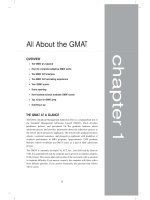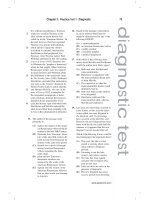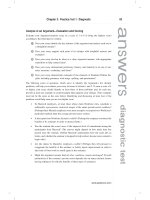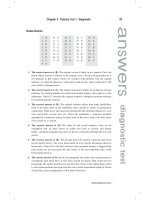Master gmat 2010 part 32 ppt
Bạn đang xem bản rút gọn của tài liệu. Xem và tải ngay bản đầy đủ của tài liệu tại đây (89.58 KB, 10 trang )
The next figure shows a circle with center O inscribed in a square. Point P is one of four points
of tangency. By definition,
OP ⊥ AB.
Also, notice the following relationships between the circle in the preceding figure and the
square in which it is inscribed (r 5 radius):
• Each side of the square is 2r in length.
• The square’s area is (2r)
2
,or4r
2
.
• The ratio of the square’s area to that of the inscribed circle is
4
p
.
• The difference between the two areas—the total shaded area—is 4r
2
2pr
2
.
• The area of each separate (smaller) shaded area is
1
4
(4r
2
2pr
2
).
For any regular polygon (including squares) that inscribes a circle:
• The point of tangency between each line segment and the circle bisects the segment.
• Connecting each vertex to the circle’s center creates an array of congruent angles,
arcs, and triangles.
For example, the left-hand figure below shows a regular pentagon, and the right-hand figure
shows a regular hexagon. Each polygon inscribes a circle. In each figure, the shaded region is
one of five (or six) identical ones.
Chapter 11: Math Review: Geometry 293
www.petersons.com
16.
In the figure above, a circle with center O is tangent to AB at point D and tangent
to
AC at point C.Ifm∠A 5 40°, then x 5
(A) 140
(B) 145
(C) 150
(D) 155
(E) 160
The correct answer is (A). Since
AC is tangent to the circle, AC ⊥ BC. Accordingly, DABC is
a right triangle, and m∠B 5 50°. Similarly,
AB ⊥ DO, DDBO is a right triangle, and
∠DOB 5 40°. ∠DOC (the angle in question) is supplementary to ∠DOB. Thus, m∠DOC 5
140° (x 5 140).
Comparing Circles
On the GMAT, questions asking you to compare circles come in two varieties:
Calculate the difference between radii, circumferences, and areas.
Determine ratios involving the two circles and their radii, circumferences, and areas.
To calculate a difference between the radii, circumferences, or areas, just calculate each area
or circumference, then subtract. And if the question asks you for a difference between the
areas of sectors of two concentric circles, first calculate the areas of each sector, then subtract
the smaller area from the larger area.
To handle questions involving ratios, you need to understand that the relationship between a
circle’s radius or circumference and its area is exponential, not linear (because A 5pr
2
). For
example, if one circle’s radius is twice that of another, the ratio of the circles’ areas is
1:4[pr
2
:p(2r)
2
]. If the larger circle’s radius is three times that of the smaller circle, the ratio is
1:9[pr
2
:p(3r)
2
]. A 1:4 ratio between radii results in a 1:16 area ratio (and so forth).
294 PART IV: GMAT Quantitative Section
TIP
The proportions
noted on this
page also apply if
you compare
circumferences
and areas. If the
circumference
ratio is 2:1, then
the area ratio
is 4:1. If the
circumference
ratio is 4:1, then
the area ratio
is 16:1.
www.petersons.com
17.
In the figure above, point O lies at the center of both circles. If the length of OP is 6
and the length of
PQ is 2, what is the ratio of the area of the smaller circle to the
area of the larger circle?
(A)
3
8
(B)
7
16
(C)
1
2
(D)
9
16
(E)
5
8
The correct answer is (D). The ratio of the small circle’s radius to that of the large circle is
6:8, or 3:4. Since Area 5pr
2
, the area ratio is p(3)
2
:p(4)
2
,or9:16.
POLYGONS
Polygons include all plane figures formed only by straight segments. Up to this point, we’ve
focused on only two types of polygons: three-sided ones (triangles) and four-sided ones
(quadrilaterals). Now take a quick look at the key characteristics of all polygons.
You can use the following formula to determine the sum of the measures of all interior angles
of any polygon whose angles each measure less than 180° (n 5 number of sides):
(n 2 2)(180°) 5 sum of interior angles
For regular polygons, the average angle measure is also the measure of every angle. But for
any polygon (except for those with an angle exceeding 180°), you can find the average angle
measure by dividing the sum of the measures of the angles by the number of sides. One way
to shortcut the math is to memorize the angle sums and averages for polygons with 3–8 sides:
3 sides: (3 2 2)(180°) 5 180° 4 3 5 60°
4 sides: (4 2 2)(180°) 5 360° 4 4 5 90°
ALERT!
A polygon in
which all sides are
congruent and all
angles are
congruent is
called a regular
polygon. But for
the GMAT, you
only need to
know the
principle, not the
terminology.
Chapter 11: Math Review: Geometry 295
www.petersons.com
5 sides: (5 2 2)(180°) 5 540° 4 5 5 108°
6 sides: (6 2 2)(180°) 5 720° 4 6 5 120°
7 sides: (7 2 2)(180°) 5 900° 4 7 ' 129°
8 sides: (8 2 2)(180°) 5 1080° 4 8 5 135°
A GMAT question might simply ask for the measure of any interior angle of a certain regular
polygon; to answer it, just apply the preceding formula. If the polygon is not regular, you can
add up known angle measures to find unknown angle measures.
18. If exactly two of the angles of the polygon shown below are congruent, what is the
LEAST possible sum of the degree measures of two of the polygon’s interior angles?
(A) 162°
(B) 174°
(C) 176°
(D) 204°
(E) 216°
The correct answer is (B). The figure shows a hexagon. The sum of the measures of six
angles is 720°. Subtracting the measures of the three known angles from 720° leaves 420°,
which is the sum of the measures of the three unknown angles. Set up an equation, then solve
for x:
x 1 x 1
4
5
x 5 420
14
5
x 5 420
x 5~420!
5
14
5~30!~5!5150
Of the three unknown angles, two are 150° each. The other is 120°. The polygon’s two smallest
angles measure 54° and 120°. Their sum is 174°.
Another, more difficult type of problem requires you to determine the area of a polygon, which
might be either regular or irregular. To do so, you need to partition the polygon into an
assemblage of smaller geometric figures.
296 PART IV: GMAT Quantitative Section
www.petersons.com
19.
What is the area of polygon ABCDE shown above?
(A)
4 1 2
=
3
(B)
3 1 3
=
2
(C)
6
=
3
(D)
2 1 6
=
2
(E)
8
=
2
The correct answer is (A). Divide the polygon into three triangles as shown below. The area
of each of the two outer triangles 5
1
2
bh 5
1
2
~2!~2!52. (Their combined area is 4.) Since the
two outer triangles are both 1:1:
=
2 right triangles, BE ≅ BD, and both line segments are 2
=
2
units long. Accordingly, the central triangle is equilateral. Calculate its area:.
s
2
=
3
4
5
~2
=
2!
2
=
3
4
5
8
=
3
4
5 2
=
3
Thus, the area of the polygon is 4 1 2
=
3.
CUBES AND OTHER RECTANGULAR SOLIDS
GMAT questions about rectangular solids always involve one or both of two basic formulas
(l 5 length, w 5 width, h 5 height):
Volume 5 lwh
Surface Area 5 2lw 1 2wh 1 2lh 5 2(lw 1 wh 1 lh)
Chapter 11: Math Review: Geometry 297
www.petersons.com
For cubes, the volume and surface-area formulas are even simpler than for other rectangular
solids (let s 5 any edge):
Volume 5 s
3
,ors 5
=
3
Volume
Surface Area 5 6s
2
A GMAT question might require you to apply any one of the formulas. Plug what you know
into the formula, then solve for whatever characteristic the question asks for. Or, a question
might require you to deal with the formulas for both surface area and volume.
20. A closed rectangular box with a square base is 5 inches in height. If the volume of
the box is 45 square inches, what is the box’s surface area in square inches?
(A) 45
(B) 66
(C) 78
(D) 81
(E) 90
The correct answer is (C). First, determine the dimensions of the square base. The box’s
height is given as 5. Accordingly, the box’s volume (45) 5 5lw, and lw 5 9. Since the base is
square, the base is 3 inches long on each side. Now you can calculate the total surface area:
2lw 1 2wh 1 2lw 5 (2)(9) 1 (2)(15) 1 (2)(15) 5 78.
A variation on the preceding question might ask the number of smaller boxes you could fit, or
“pack,” into the box that the question describes. For instance, the number of cube-shaped
boxes, each one 1.5 inches on a side, that you could pack into the 3 3 3 3 5 box is 12 (3 levels
of 4 cubes, with a half-inch space left at the top of the box).
A test question involving a cube might focus on the ratios among the cube’s linear, square, and
cubic measurements.
21. If the volume of one cube is 8 times greater than that of another, what is the ratio of
the area of one square face of the larger cube to that of the smaller cube?
(A) 16:1
(B) 12:1
(C) 8:1
(D) 4:1
(E) 2:1
298 PART IV: GMAT Quantitative Section
www.petersons.com
The correct answer is (D). The ratio of the two volumes is 8:1. Thus, the linear ratio of the
cubes’ edges is the cube root of this ratio:
=
3
8:
=
3
1 5 2:1. The area ratio is the square of the
linear ratio, or 4:1.
CYLINDERS
The only kind of cylinder the GMAT covers is a “right” circular cylinder (a tube sliced at 90°
angles). The surface area of a right cylinder is the sum of the areas of:
• The circular base
• The circular top
• The rectangular surface around the cylinder’s vertical face (visualize a rectangular
label wrapped around a soup can)
The area of the vertical face is the product of the circular base’s circumference (i.e., the
rectangle’s width) and the cylinder’s height. Thus, given a radius r and height h of a cylinder:
Surface Area (SA) 5 2pr
2
1 (2pr)(h)
Given a cylinder’s radius and height, you can determine its volume by multiplying the area of
its circular base by its height:
Volume 5pr
2
h
On the GMAT, a cylinder problem might require little more than a straightforward
application of formula for either surface area or volume. As with rectangular-solid questions,
just plug what you know into the formula, then solve for what the question asks. For example:
Given a radius of 3 and a height of 7, a right cylinder’s volume 5p(3)
2
(7) 5 63p.
A tougher cylinder problem might require you to apply other math concepts. It also might call
for you to convert one unit of measure into another.
Chapter 11: Math Review: Geometry 299
www.petersons.com
22. One hose dispenses water at the rate of one gallon per minute, and a second hose
dispenses water at the rate of 1
1
2
gallons per minute.
At the same time, the two hoses begin filling a cylindrical pail whose diameter is
14 inches and whose height is 10 inches. Which of the following most closely
approximates the water level, measured in inches up from the pail’s circular base,
after 1
1
2
minutes? [231 cubic inches 5 1 gallon]
(A) 3.5
(B) 4.2
(C) 4.8
(D) 5.6
(E) 6.7
The correct answer is (D). After 1
1
2
minutes, the two hoses have dispensed a total of 3.75
gallons. Set up a proportion in which 3.75 as a portion of the pail’s volume equals the water
level after 1
1
2
minutes as a portion of the pail’s height:
3.75
V
5
x
10
The volume of the cylindrical pail is equal to the area of its circular base multiplied by
its height:
V 5pr
2
h '
S
22
7
D
~49!~10!'1540 cubic inches
The gallon capacity of the pail 5 1540 4 231, or about 6.7. Plug this value into the proportion,
then solve for x:
3.75
6.7
5
x
10
6.7x 5 37.5
x 5 5.6
COORDINATE SIGNS AND THE FOUR QUADRANTS
GMAT coordinate geometry questions involve the rectangular coordinate plane (or xy-plane)
defined by two axes—a horizontal x-axis and a vertical y-axis. You can define any point on the
coordinate plane by using two coordinates: an x-coordinate and a y-coordinate. A point’s
x-coordinate is its horizontal position on the plane, and its y-coordinate is its vertical position
on the plane. You denote the coordinates of a point with (x,y), where x is the point’s
x-coordinate and y is the point’s y-coordinate.
The center of the coordinate plane—the intersection of the x and y axes—is called the origin.
The coordinates of the origin are (0,0). Any point along the x-axis has a y-coordinate of 0 (x,0),
300 PART IV: GMAT Quantitative Section
www.petersons.com
and any point along the y-axis has an x-coordinate of 0 (0,y). The coordinate signs (positive or
negative) of points lying in the four quadrants I–IV in this next figure are as follows:
Quadrant I (1,1)
Quadrant II (2,1)
Quadrant III (2,2)
Quadrant IV (1,2)
III
II
I
IV
Notice that we’ve plotted three different points on this plane. Each point has its own unique
coordinates. (Before you read on, make sure you understand why each point is identified by
two coordinates.)
DEFINING A LINE ON THE COORDINATE PLANE
You can define any line on the coordinate plane by the equation:
y 5 mx 1 b
In this equation:
• The variable m is the slope of the line.
• The variable b is the line’s y-intercept (where the line crosses the y-axis).
• The variables x and y are the coordinates of any point on the line. Any (x,y) pair
defining a point on the line can substitute for the variables x and y.
Determining a line’s slope is often crucial to solving GMAT coordinate geometry problems.
Think of the slope of a line as a fraction in which the numerator indicates the vertical change
from one point to another on the line (moving left to right) corresponding to a given horizontal
change, which the fraction’s denominator indicates. The common term used for this fraction is
“rise-over-run.”
Chapter 11: Math Review: Geometry 301
www.petersons.com
You can determine the slope of a line from any two pairs of (x,y) coordinates. In general, if
(x
1
,y
1
) and (x
2
,y
2
) lie on the same line, calculate the line’s slope as follows (notice that you can
subtract either pair from the other):
slope ~m!5
y
2
2 y
1
x
2
2 x
1
or
y
1
2 y
2
x
1
2 x
2
In applying the preceding formula, be sure to subtract corresponding values. For example, a
careless test taker calculating the slope might subtract y
1
from y
2
but subtract x
2
from x
1
.
Also, be sure to calculate “rise-over-run,” and not “run-over-rise”—another careless but
relatively common error.
As another example, here are two ways to calculate the slope of the line defined by the two
points P(2,1) and Q(23,4):
slope ~m!5
4 2 1
23 2 2
5
3
25
slope ~m!5
1 2 4
2 2~23!
5
23
5
A GMAT question might ask you to identify the slope of a line defined by a given equation, in
which case you simply put the equation in the standard form y 5 mx 1 b, then identify the
m-term. Or, it might ask you to determine the equation of a line, or just the line’s slope (m)or
y-intercept (b), given the coordinates of two points on the line.
23. On the xy-plane, at what point along the vertical axis (the y-axis) does the line
passing through points (5, 22) and (3,4) intersect that axis?
(A) 28
(B)
2
5
2
(C) 3
(D) 7
(E) 13
The correct answer is (E). The question asks for the line’s y-intercept (the value of b in the
general equation y 5 mx 1 b). First, determine the line’s slope:
slope m 5
y
2
2 y
1
x
2
2 x
1
5
4 2~22!
3 2 5
5
6
22
523
In the general equation (y 5 mx 1 b), m 523. To find the value of b, substitute either (x,y)
value pair for x and y, then solve for b. Substituting the (x,y) pair (3,4):
y 523x 1 b
4 523~3!1b
4 529 1 b
13 5 b
302 PART IV: GMAT Quantitative Section
www.petersons.com









